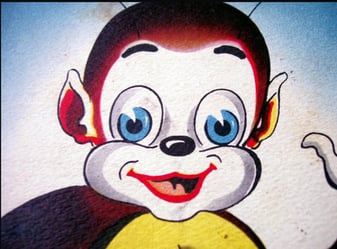Most of us who have children, or have been children, can find ourselves murmuring, “A told B and B told C, I’ll meet you at the top of the coconut tree” the way others absentmindedly hum a song from the radio. The knowledge that he once wanted his work to be compared to jazz music is no great surprise, as Bill Martin Jr. penned many books like Chicka Chicka Boom Boom—a story about an alphabet made up of naughty lowercase letters who climb up a coconut tree and are sent crashing down only to be rescued by their uppercase parents—all geared towards the inquisitive, rhythm-hungry minds of children.
 The world is full of storybooks and narrative tales for children, but this signature style of Martin’s was what made him stand apart from others. He came by this talent honestly and found that it was just the way he worked. He is quoted as saying: “"I don't write books, I talk them, I write to a melody."
The world is full of storybooks and narrative tales for children, but this signature style of Martin’s was what made him stand apart from others. He came by this talent honestly and found that it was just the way he worked. He is quoted as saying: “"I don't write books, I talk them, I write to a melody."
It is this melody, flat on the page, with no background music to aid the reader, that creates a natural sing-song quality that is infectious and delightful for children just learning to read and follow narratives. This rhythm has a natural origin; Martin was riding a commuter train on his way to his public school teaching job and was struck with how familiar and pleasing the gentle sound of the train was. Wanting to capture this sensation in written form, and to communicate it to an audience, he grabbed a newspaper and a a pen and wrote the entire text of Brown Bear, Brown Bear in the margins while listening to the train. As fortune would have it, Martin was a close friend of Eric Carle, who signed on to illustrate the book, and a classic was born.
This desire to appeal to the mind of a child, while also offering instruction through storytelling may seem like a natural coupling for someone with a doctorate in education and a career creating reading programs for schools and educators. There is another reason, however, for this particular passion in Martin.
For most of his life, before seeking a higher degree in education, he couldn’t read. He grew up in a household without books, and was able to mask his “print blindness” well enough that he was seen only as lazy, not as illiterate, until he went to college. He credits his elementary school teacher, Miss Davis, who read to the class every day, for his love of language and his desire for books and stories. In this way, he became a reader long before he was able to make sense of the print on the page.
In college, he became literate with the help of a professor and his own ability to listen to text aloud and then apply what he had heard to the words on a page. This reverse engineering and determination of will drove him to succeed and to also look out for other children who, like him, struggled with language even when they had a deep love for it. They key, he found, was rhythm and repetition. When on a book tour, he would visit schools and book stores and would not just read, but perform, using singing and dancing to interact with his audiences of tiny ears and large imaginations.
 Graduating with a doctorate in early childhood education from Northwestern University, Martin went on to provide both the language and the tools for children to find their voices and enjoy the stories they loved independently. He wrote his first book, The Little Squeegy Bug, in 1945, while serving as a newspaper editor in the Air Force. He was fortunate that it caught the eye of the first lady, Eleanor Roosevelt, who talked about it in her weekly column. A million copies later it was a bonafide hit and Martin began a writing career that would span decades and find him becoming the voice, as Miss Davis had for him, of stories for millions of future readers.
Graduating with a doctorate in early childhood education from Northwestern University, Martin went on to provide both the language and the tools for children to find their voices and enjoy the stories they loved independently. He wrote his first book, The Little Squeegy Bug, in 1945, while serving as a newspaper editor in the Air Force. He was fortunate that it caught the eye of the first lady, Eleanor Roosevelt, who talked about it in her weekly column. A million copies later it was a bonafide hit and Martin began a writing career that would span decades and find him becoming the voice, as Miss Davis had for him, of stories for millions of future readers.
A recipient of many awards and honors, including a place in the the Reading Hall of Fame, Martin also has an award in his name, The Bill Martin Jr. Award, which is the Kansas state award for best children's picture book.
Bill Martin Jr. passed away at his home in 2004. He was 88 years old.
BILL MARTIN JR. (n.d.). Retrieved February 25, 2016, here.
Lyons, Dan P. (2014, July 11 ). Chicka Chicka Boom Boom [Video file]. Retrieved here.
Martin, B., Jr. (n.d.). Bill Martin, Jr. Retrieved February 25, 2016, here.
Rourke, M. (2004, August 17). Bill Martin Jr., 88; Author of Classic Books for Young Readers. Los Angeles Times. Retrieved February 25, 2016, here.
A video interview with Bill Martin Jr. (2015). Retrieved February 25, 2016, here.









